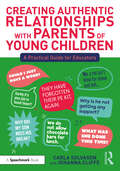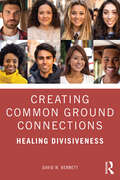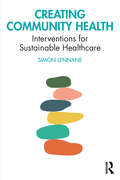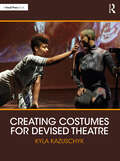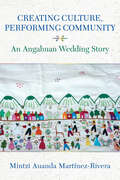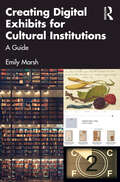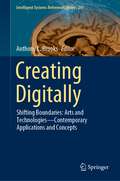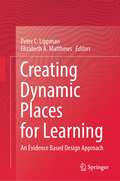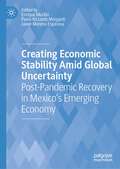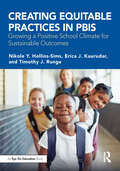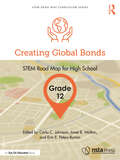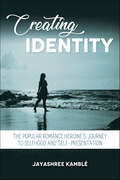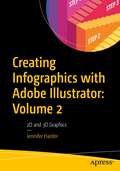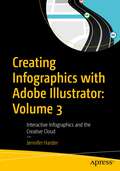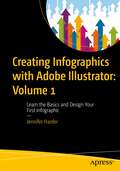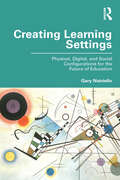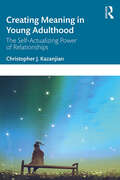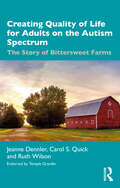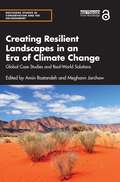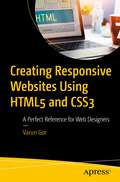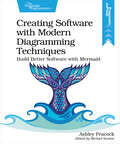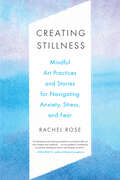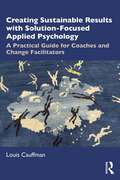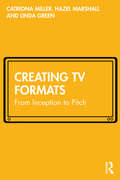- Table View
- List View
Creating Authentic Relationships with Parents of Young Children: A Practical Guide for Educators
by Carla Solvason Johanna CliffeDealing with parents can be scary and intimidating, especially when you are relatively new to your role, but it can also be hugely rewarding. What do you need to know? Which barriers are you likely to face? Most importantly, how can you nurture a positive and authentic relationship with parents and carers where you genuinely work together for the best interests of the child? Written by authors who have experienced being on both sides of the fence, as educators and as parents, this practical book takes a frank approach to recognising the turbulent world of parenting and shines a light on issues that are, all too often, dismissed. It considers the pragmatic, kind, and caring ways that educational settings can support parents’ struggles, as well as benefitting from their wide-ranging knowledge and capabilities. With activities and reflections included throughout, the book invites the reader to consider their practice, and to look at their relationships with parents with fresh eyes, all whilst keeping the child in mind. With a focus on celebrating the value of truly listening and forming authentic relationships, this book will be essential reading for early years’ educators, childminders, primary teachers, TAs, and SENCOs.
Creating Common Ground Connections: Healing Divisiveness
by David W. BennettThrough an empathetic and positive approach to interpersonal communication, this book guides readers to build on the skills they already possess to communicate—and connect—with others. Author David W. Bennett, Ph.D. approaches communication with the belief that it is at the heart of any human division. This book helps readers find a way to communicate that will help build understanding regardless of each party’s perspective. Written in an approachable and conversational style, the book includes tips, examples, and concept reviews to easily illustrate communication principles readers can take with them beyond their courses or training sessions. An ideal supplement to courses focusing on skills in interpersonal, professional, or business communication, this book can also be used as a communication primer for students or professionals in any field.
Creating Community Health: Interventions for Sustainable Healthcare
by Simon LennaneThis important book explores how community-based interventions can bridge the gap between health services and the voluntary sector to create more sustainable, healthy communities. Moving beyond a technologically driven, medicalised approach to healthcare, the book shows how social prescribing can provide a direct pathway to improving community health, embracing connection and challenging inequality. Written by a practicing GP, and illustrated through practical guidance, it demonstrates how this can offer a cost-effective, preventative means to improving health outcomes, enabling communities to be more resilient when confronting major issues such as climate change or pandemics. Building to a case study of how these methods were used in one town, Ross-on-Wye, the book will be invaluable reading for those working in healthcare, public health, local authorities, and the voluntary sector, as well as students and researchers interested in these areas.
Creating Costumes for Devised Theatre
by Kyla KazuschykCreating Costumes for Devised Theatre combines perspectives from a variety of theatre practitioners to guide artists through the journey of creating costumes for devised work. Devised theatre can take a number of different forms, and it can be a challenge for the costume department to plan, organize, and assemble things for performers to wear while the entire shape of the piece is constantly changing. This book provides practical resources to guide the theatre artist through the journey of designing costumes as the characters are created. It addresses a wide range of questions, including how to adapt traditional methods of costume design to non-traditional practices, how to effectively collaborate with a team, and how to adapt costume technology practices to meet the needs of devising. Stories and photographs from performers, designers, technicians, directors, writers, educators, students, and activists working in the realm of devised theatre around the world are contextualized through the author's own involvement in unscripted, partially scripted, and otherwise dynamic drama, dance, and physical theatre to offer tangible solutions to streamline costume design and construction processes. This book is an invaluable guide for both experienced and novice costume designers, costume technicians, students, teachers, directors, managers, and theatre artists who exist in the spaces where all these roles overlap.
Creating Culture, Performing Community: An Angahuan Wedding Story (Underground Cultures)
by Mintzi Auanda Martínez-RiveraCreating Culture, Performing Community explores the ways in which the people of Santo Santiago de Angahuan, a P'urhépecha community in the state of Michoacán, México, create and curate their cultural practices and how, by doing so, they perform what it means to be an active member of the P'urhépecha community. Through a deep ethnographic account of ritual practices, author Mintzi Auanda Martínez-Rivera focuses on the tembuchakua, or wedding rituals, analyzing their creation, performance, and transformation within the P'urhépecha community. By proposing alternative approaches to understanding indigeneity, Martínez-Rivera showcases how people carefully transform their cultural practices and rearticulate and perform their identities.Thus Creating Culture, Performing Community has three main aims: to analyze how people create their own culture; to showcase how cultural practices are performed to reflect particular ideas of what it means to be a member of a community; and to move beyond limited understandings of indigenous identity and cultural practices.
Creating Digital Exhibits for Cultural Institutions: A Guide
by Emily MarshCreating Digital Exhibits for Cultural Institutions will show you how to create digital exhibits and experiences for your users that will be informative, accessible and engaging. Illustrated with real-world examples of digital exhibits from a range of GLAMs, the book addresses the many analytical aspects and practical considerations involved in the creation of such exhibits. It will support you as you go about: analyzing content to find hidden themes, applying principles from the museum exhibit literature, placing your content within internal and external information ecosystems, selecting exhibit software, and finding ways to recognize and use your own creativity. Demonstrating that an exhibit provides a useful and creative connecting point where your content, your organization, and your audience can meet, the book also demonstrates that such exhibits can provide a way to revisit difficult and painful material in a way that includes frank and enlightened analyses of issues such as racism, colonialism, sexism, class, and LGBTQI+ issues. Creating Digital Exhibits for Cultural Institutions is an essential resource for librarians, archivists, and other cultural heritage professionals who want to promote their institution’s digital content to the widest possible audience. Academics and students working in the fields of library and information science, museum studies and digital humanities will also find much to interest them within the pages of this book.
Creating Digitally: Shifting Boundaries: Arts and Technologies—Contemporary Applications and Concepts (Intelligent Systems Reference Library #241)
by Anthony L. BrooksThis book of 21 chapters shares endeavors associated to the human trait of creative expression within, across, and between digital media in wide-ranging contexts making the contents perfect as a course study book uptake within related educations. Globally located chapter authors share their comprehensive artisan perspectives from works associated with regional cultures, diversities of interpretations, and widespread scopes of meanings. Contents illustrate contemporary works reflecting thought-provoking comprehensions, functions, and purposes, posit as contributing toward shifting of boundaries within the field. Original to this approach is the reflective offerings on creating digitally beyond typical psychological analysis/rapportage. The book's general scope and key uses are thus to contribute to scholarly discussions toward informing future projects by having an intended wide readership including from within educations, to artisans, and wider interested public.Chapter 7 is available open access under a Creative Commons Attribution 4.0 International License via link.springer.com.
Creating Dynamic Places for Learning: An Evidence Based Design Approach
by Peter C. Lippman Elizabeth A. MatthewsThis book showcases how an evidence-based design approach can be utilized in the planning of learning environments, by acknowledging the interconnectedness of research, practice, and theory as core considerations in the design of learning environments. Toward this end, this volume explores a multi-disciplinary perspective that draws upon modern learning theories, and empirical research from the fields of environmental psychology education, and architectural practice. By presenting this information in an accessible manner, it enables researchers, educators and designers to take actionable steps needed to re-imagine their settings and create dynamic places for learning.
Creating Economic Stability Amid Global Uncertainty: Post-Pandemic Recovery in Mexico’s Emerging Economy
by Enrique Murillo Paolo Riccardo Morganti Javier Moreno EspinosaCOVID-19 impacted economic activity in a way that hurt households, businesses, industries, and governments. What followed immediately was a period of high uncertainty, and what’s to come is still unknown. Economists have a lot to learn from this point in history, as different countries have handled this very differently from others. This book journeys through what one emerging economy has done to attempt recovery following immense disruption: Mexico's recovery following the pandemic. This volume offers empirical studies that trace the post-pandemic recovery period in Mexico, providing insight into what this emergent economy went through and did after 2021. The first part of the book examines macroeconomics, such as tax collection, and microeconomics, such as household income. These chapters draw on policy and the actions driving the economic recover in this emergent economy. The second half of the book focuses on what organizations can do to improve internal governance as well as market success.Full of new conceptual and empirical studies, the book explains what it looks like to rebuild an emerging economy. It will appeal to economists, economic scholars, and policymakers trying to make sense of the best ways to move forward following intense period of economic instability.
Creating Equitable Practices in PBIS: Growing a Positive School Climate for Sustainable Outcomes
by Timothy J. Runge Nikole Y. Hollins-Sims Erica J. KaurudarThis go-to resource guides educators on how to incorporate equitable practices in a PBIS framework. The authors cover core concepts including school-wide positive behavioral interventions and supports (SWPBIS) and multi-tiered system of supports (MTSS), define equity, and present methods for enhancing implementation practices through an equity mindset. Chapters also include an analysis of team structures and the evaluation of baseline data sources, walking readers through how to incorporate effective practices to support an integrated MTSS framework and produce sustainable outcomes. This book is ideal for educators, behavioral specialists, and administrators who wish to promote a positive school climate and purposeful educational relationships.
Creating Global Bonds, Grade 12: STEM Road Map for High School (STEM Road Map Curriculum Series)
by Janet B. Walton Peters-Burton, Erin E.What if you could challenge your twelfth-grade students to explore energy consumption and climate change in their own communities, and connect that information with other communities around the world? With this volume in the STEM Road Map Curriculum Series, you can! Creating Global Bonds outlines a journey that will steer your students toward authentic problem solving while grounding them in integrated STEM disciplines. Like the other volumes in the series, this book is designed to meet the growing need to infuse real-world learning into K–12 classrooms. This interdisciplinary, three-lesson module uses project- and problem-based learning to help students create an action plan to address issues of energy consumption and climate change, exploring the topic at both local and global levels. Students will gather data on energy consumption and climate change in their communities, partnering with international students to undertake problem-solving activities that examine issues that are both common and unique to each community. To support this goal, students will do the following: · Identify modes and trends in energy consumption in their communities and regions; · Analyze how those patterns of energy consumption impact climate change; · Partner with students internationally to coordinate efforts to synthesize energy consumption data and discern connections across contexts, taking the form of an international blog; · Design and present an action plan to address issues of energy consumption and climate change, ultimately delivering a white paper and interactive web-based presentation on local and international issues of energy consumption and climate change. The STEM Road Map Curriculum Series is anchored in the Next Generation Science Standards, the Common Core State Standards, and the Framework for 21st Century Learning. In-depth and flexible, Creating Global Bonds can be used as a whole unit or in part to meet the needs of districts, schools, and teachers who are charting a course toward an integrated STEM approach.
Creating Identity: The Popular Romance Heroine's Journey to Selfhood and Self-Presentation
by Jayashree KambléWhile the world often categorizes women in reductive false binaries—careerist versus mother, feminine versus fierce—romance novels, a unique form of the love story, offer an imaginative space of mingled alternatives for a heroine on her journey to selfhood.In Creating Identity, Jayashree Kamblé examines the romance genre, with its sensile flexibility in retaining what audiences find desirable and discarding what is not, by asking an important question: "Who is the romance heroine, and what does she want?" To find the answer, Kamblé explores how heroines in ten novels reject societal labels and instead remake themselves on their own terms with their own agency. Using a truly intersectional approach, Kamblé combines gender and sexuality, Marxism, critical race theory, and literary criticism to survey various aspects of heroines' identities, such as sexuality, gender, work, citizenship, and race. Ideal for readers interested in gender studies and literary criticism, Creating Identity highlights a genre in which heroines do not accept that independence and strong, loving relationships are mutually exclusive but instead demand both, echoing the call from the very readers who have made this genre so popular.
Creating Infographics with Adobe Illustrator: 2D and 3D Graphics
by Jennifer HarderThis full-color book will teach you how to use Adobe Illustrator's various tools to create infographics, as well as basic page layouts for them. It focuses on Illustrator’s powerful graphing tools and 2D and 3D effects. How can an infographic or graph be altered and adapted to appear more engaging and still display your data accurately? What additional effects can be used on your infographic to produce the results you envision? In this second volume of Creating Infographics with Adobe Illustrator, you will learn the answers to all these questions. Author Jennifer Harder will walk you through creating basic infographics in Illustrator using Illustrator tools such as Graphing Tools as well as how to create 2D effects and 3D shapes with their related materials, including Symbols. Upon completing this volume, you will have an appreciation for how easy it is to design an infographic or graph to display your data and discover how rudimentary shapes and colors can be altered using patterns, as well as 2D and 3D effects, to enhance readability while conveying meaning to your audience. You will be able to use this knowledge to create your own infographics using Illustrator’s wide array of tools. What You Will Learn Use Illustrator’s Graphing Tools to create and modify basic charts or graphsWork with popular 2D effects to enhance your design in IllustratorCreate 3D Shapes using Materials and Symbols and modify your 3D GraphsExplore basic Image Trace and Perspective options in Illustrator Who This Book Is For Beginner-level designers and others who are interested in learning the process of creating infographics for their company, the classroom, for data visualization, an article in a magazine, or a webpage.
Creating Infographics with Adobe Illustrator: Interactive Infographics and the Creative Cloud
by Jennifer HarderThis full-color book, the third of three volumes, focuses on Adobe Illustrator’s SVG interactivity tools. How can an infographic be made more interactive for an audience? What additional Illustrator tools and Adobe applications can be used to enhance your infographic layout? In this final volume of Creating Infographics with Adobe Illustrator, you will learn the answers to all these questions. Author Jennifer Harder will walk you through creating basic infographics in Illustrator using Illustrator tools for creating SVG files, known as Scalable Vector Graphics, for basic Interactivity on a web page. Then you will review layouts in other Adobe Applications in relation to their connectivity with Illustrator. Upon completing this volume, you will have a thorough understanding of how to design an infographic with basic interactivity for a web page, and how this can improve visualization and convey meaning to your audience. Moreover, you will be able to use this knowledge to create your own infographics using Illustrator’s wide array of tools. What You Will Learn Discover how to apply interactivity to an infographicGain insight into different infographic layouts and how to finalize your project with your clientExplore other Adobe Creative Cloud applications that may assist you in the future as you create your infographics Who This Book Is For Beginner-level designers and others who are interested in learning the process of creating infographics for their company, the classroom, for, an article in a magazine, or adding interactivity to webpage.
Creating Infographics with Adobe Illustrator: Learn the Basics and Design Your First Infographic
by Jennifer HarderThis full-color book will teach you how to use Adobe Illustrator's various tools to create infographics, as well as basic page layouts for them. This is the first of three volumes which will cover all the fundamentals of Illustrator, an industry standard application used by graphic designers and marketing and communication teams. How is an infographic different from a logo or any other illustration? What additional thought processes, skills, or software tools should be utilized to create an infographic? In this first volume of Illustrator Basics, you will learn the answers to all these questions. Author Jennifer Harder will walk you through creating basic infographics in Illustrator using Basic Shape tools, Pen Tools, Type Tools, and Symbols. Upon completing this volume, you will have an appreciation for how easy it is to design an infographic and discover how rudimentary shapes and colors can affect readability while conveying meaning to your audience. You will be able to use this knowledge to create your own infographics using Illustrator’s wide array of tools. Who This Book Is For Discover the tools within Illustrator that are ideal for creating basic infographicsDevelop a logo based upon a scanned sketchGain an understanding of different infographic layouts and the process of reviewing them with your client Who This Book Is For Beginner-level designers and others who are interested in learning the process of creating infographics for their company, the classroom, for a visual resume, an article in a magazine, or a webpage.
Creating Learning Settings: Physical, Digital, and Social Configurations for the Future of Education
by Gary NatrielloCreating Learning Settings examines the design and implementation of learning settings informed by the newest, most expansive insights into how people learn in the post-industrial age. Educators today are tasked with moving beyond the fixed, traditional practices that have long dominated formal schooling and becoming more dynamic and strategic in arranging learners, facilitators, resources, on-site and virtual environments, and learning experiences. Integrating contemporary theoretical approaches and empirical studies, this book offers a systematic approach to creating settings that leverage the physical, digital, resource, and social dimensions necessary to support learning.
Creating Meaning in Young Adulthood: The Self-Actualizing Power of Relationships
by Christopher J. KazanjianCreating Meaning in Young Adulthood explores the ways in which young adults are creating meanings in life through their relationships with the world. Chapters synthesize research in the fields of child psychology, counseling, multicultural education, and existential-humanistic psychology to offer readers a contemporary understanding of the greater challenges for growth and development that youth currently face. Using ample case studies, the book also sets forth a resilience-based approach for helping readers facilitate the healing, growth, and enlightenment of young adults.
Creating Our Own Lives: College Students with Intellectual Disability
by Michael Gill Beth MyersYoung adults with intellectual disability tell the story of their own experience of higher education How do students with intellectual disability experience higher education? Creating Our Own Lives addresses this question through the eyes of participants themselves. In relating their experiences and aspirations, these student perspectives mount a powerful challenge to assumptions that intellectual disability is best met with protection or segregation. Taken together, the essays expose and contradict the inherently ableist claim that individuals with intellectual disability cannot be reliable storytellers. Instead, their deeply informative stories serve as a corrective narrative. The first of the four sections, &“Laying the Foundation: Why Everyone Belongs in College,&” focuses on belonging and inclusion; the second, &“Opening Up Possibilities: Overcoming Doubt and Uncertainty,&” conveys the optimism of this generation of advocates through stories of personal hardship, hopeful perseverance, and triumph over adversity; the third, &“Inclusion as Action: Diversifying Student Experiences,&” supports the understanding of diverse student experiences in inclusive higher education; and the fourth, &“Supporting Growth: Peer Mentoring and Advice,&” offers guidance to those reimagining and creating educational spaces. Students with disabilities belong in higher education. Not only does this book serve as an important record of students enrolled in inclusive higher education programs, it is also an unprecedented resource, packed with information and inspiration both for parents seeking opportunities for their children and for individuals with intellectual disability who aspire to attend college. Contributors: Makayla Adkins, Olivia Baist, Brandon Baldwin, George Barham, Marquavious Barnes, Katie Bartlett, Steven Brief, De'Onte Brown, Meghan Brozaitis, Mary Bryant, Gracie Carrol, Taylor Cathey, Maia Chamberlain, Antonio E. Contreras, Kim Dean, Elizabeth Droessler, Katie Ducett, Keiron Dyck, Rachel Gomez, Deriq Graves, Micah Gray, Maggie Guillaume, Cleo Hamilton, Nathan Heald, Joshua R. Hourigan, Hannah Lenae Humes, Courtney Jorgensen, Eilish Kelderman, Kailin Kelderman, Kenneth Kelty, Kaelan Knowles, Karlee Lambert, Kate Lisotta, Rachel Mast, Elise McDaniel, Emma Miller, Jake Miller, Lydia Newnum, Brenna Mantz Nielsen, Carly O&’Connell, Nadia Osbey, Stirling Peebles, Breyan Pettaway, Amanda Pilkenton, True Rafferty, Taylor Ruppe, Lawrence Sapp, Tyler Shore, Brianna Silva, Alex Smith, Elliott Smith, Phillandra Smith, Payton Storms, Allen Thomas, Kylie Walter, Stephen Wanser, Sayid Webb, Breana Whittlesey, Luke Wilcox, Adam Wolfond.
Creating Quality of Life for Adults on the Autism Spectrum: The Story of Bittersweet Farms
by Ruth Wilson Jeanne Dennler Carol S. QuickCreating Quality of Life for Adults on the Autism Spectrum: The Story of Bittersweet Farms provides an overview of the first farmstead community for adults with autism established in North America. The book also provides a detailed description and evaluation of the intervention model used to promote quality of life for the adults with autism who live as residents at Bittersweet Farms. Through its aim to provide a better understanding of adults with autism spectrum disorder (ASD), the text enables a deeper appreciation of the Bittersweet Farms model, which meets the residential and therapeutic needs of this population that are not often well understood. The book discusses the apprenticeship model used at Bittersweet Farms along with examples of how residents benefit from this approach. The text expands upon its approach through the inclusion of specific guidelines that can be adopted for improved communication and social interaction, managing troublesome behaviors, calming anxieties, and establishing daily routines. These guidelines reflect a positive approach to intervention and are consistent with the quality-of-life emphasis inherent in the Bittersweet model. This book will serve as a seminal work for professionals and paraprofessionals working with people with ASD. It will further be of interest to parents and relatives of people with ASD along with researchers and policymakers concerned about the ASD adult population, and those interested in services for people with ASD.
Creating Resilient Landscapes in an Era of Climate Change: Global Case Studies and Real-World Solutions (Routledge Studies in Conservation and the Environment)
by Amin Rastandeh Meghann JarchowThis book delivers a realistic and feasible framework for creating resilient landscapes in an era of anthropogenic climate change. From across six continents, this book presents fifteen case studies of differing sociocultural, economic, and biophysical backgrounds that showcase opportunities and limitations for creating resilient landscapes throughout the world. The potential to create socio-ecological resilience is examined across a wide range of landscapes, including agricultural, island, forest, coastal, and urban landscapes, across sixteen countries: Argentina, Australia, Brazil, Denmark, Finland, Greece, Guatemala, Japan, Mexico, Norway, Samoa, South Africa, the United States, Turkey, Uruguay, and Vanuatu. Chapters discuss current and future issues around creating a sustainable food system, conserving biodiversity, and climate change adaptation and resilience, with green infrastructure, nature-based architecture, green-tech, and ecosystem services as just a few of the approaches discussed. The book emphasizes solution-oriented approaches for an "ecological hope" that can support landscape resiliency in this chaotic era, and the chapters consider the importance of envisioning an unpredictable future with numerous uncertainties. In this context, the key focus is on how we all can tackle the intertwined impacts of climate change, biodiversity loss, and large-scale land-cover conversion in urban and non-urban landscapes, with particular attention to the concept of landscape resiliency. The volume provides that much-needed link between theory and practice to deliver forward-thinking, practical solutions. This book will be of great interest to students, researchers, practitioners and policymakers who are interested in the complex relationship between landscapes, climate change, biodiversity loss, and land-based conversion at local, national and global scales.
Creating Responsive Websites Using HTML5 and CSS3: A Perfect Reference for Web Designers
by Varun GorLearn to implement web designs using HTML5 and CSS3. This book focuses on the need for responsive web design and how you can leverage HTML5 and CSS3 to create interactive websites that work in the real world. You do not need be a technology expert or have a prior coding background to benefit from this book. All you need is a want to learn and a curious mind to explore the full spectrum of features HTML5 and CSS3 have to offer.You'll see how to migrate legacy websites to responsive websites in a very easy-to-understand, step-by-step, manner. Additionally, you will learn to use supportive software to create, run, and debug any issues that may arise during the development process. This book will also show you how to implement websites that work on multiple devices, and on various browsers such as Opera, Chrome, internet Explorer, or Edge. All this will be explored with supporting files, open-source software, as well as a practical guide to creating your demo website along with learning new technologies.From the basics to more advanced topics, Creating Responsive Websites Using HTML and CSS is for anyone who wants to learn about and build beautiful responsive websites. What You'll LearnCode and design websites using HTML5 and CSS3 Design professional-looking websites using colors, margins, images, and other aspectsCreate a responsive design that will work on laptops, PCs, and any kind of mobile deviceTroubleshoot and fix code errors independently using developer toolsSolve cross-browser responsiveness issues and the challenges that come with different operating systemsWho This Book Is ForStudents and/or website designers who want to upskill their talents
Creating Software with Modern Diagramming Techniques: Build Better Software With Mermaid
by Ashley PeacockDiagrams communicate relationships more directly and clearly than words ever can. Using only text-based markup, create meaningful and attractive diagrams to document your domain, visualize user flows, reveal system architecture at any desired level, or refactor your code. With the tools and techniques this book will give you, you'll create a wide variety of diagrams in minutes, share them with others, and revise and update them immediately on the basis of feedback. Adding diagrams to your professional vocabulary will enable you to work through your ideas quickly when working on your own code or discussing a proposal with colleagues. Expand your professional vocabulary by learning to communicate with diagrams as easily and naturally as speaking or writing. This book will provide you with the skills and tools to turn ideas into clear, meaningful, and attractive diagrams in mere minutes, using nothing more complicated than text-based markup. You'll learn what kinds of diagrams are suited to each of a variety of use cases, from documenting your domain to understanding how complex code pieces together. Model your software's architecture, creating diagrams focused broadly or narrowly, depending on the audience. Visualize application and user flows, design database schemas, and use diagrams iteratively to design and refactor your application. You'll be able to use technical diagramming to improve your day-to-day workflow. You will better understand the codebase you work in, communicate ideas more effectively and immediately with others, and more clearly document the architecture with C4 diagrams. Manually creating diagrams is cumbersome and time-consuming. You'll learn how to use text-based tools like Mermaid to rapidly turn ideas into diagrams. And You'll learn how to keep your diagrams up to date and seamlessly integrated into your engineering workflow. You'll be better at visualizing and communicating when you add diagrams to your standard vocabulary. What You Need: A Mac or PC A GitHub account
Creating Stillness: Mindful Art Practices and Stories for Navigating Anxiety, Stress, and Fear
by Rachel RoseDiscover the healing power of expressive arts with this hands-on guide to using creative mindfulness to reduce stress, find presence, and unlock self-knowledge Expressive arts educator Rachel Rose weaves together mindfulness practice and art therapy to demonstrate how tapping into your own innate creativity can help you find peace in a stressful worldThis self-directed guide teaches ten key principles of mindfulness through ten creative invitations, along with a series of simple exercises and guided prompts to help you start noticing and flexing your creative mindfulness muscles: Anchoring your practice with ritual Setting intentions Honoring your impulses Trusting the process Non-striving Letting goRequiring no prior experience of the arts or mindfulness meditation, Creating Stillness provides tools to explore difficult emotions and find insight into personal struggles and traumatic wounds.In each chapter, Rose draws from her personal experience as a teacher and facilitator of creative mindfulness to share stories and examples that help ground exercises like sketching, creative writing prompts, and more.Rose carefully walks through the process each time, explaining how to set intention and arrive in the present moment before embarking on your mindful art session; how to use objects and thoughts as creative prompts; how to return your attention to your work as you move forward; and how to distill the wisdom you have found in the process. For seasoned artists, creative mindfulness offers a chance to slow down and rediscover the transformative power that art can offer when it is detached from the need to produce something beautiful or useful. For those coming to expressive arts with existing mindfulness practices or engaged in a therapeutic process, a mindful arts practice may reveal a passion for creation you didn&’t know existed. And for everyone, creative mindfulness can help us make sense of our feelings and find new ways of expressing ourselves--in art and in life.
Creating Sustainable Results with Solution-Focused Applied Psychology: A Practical Guide for Coaches and Change Facilitators
by Louis CauffmanThis practical, evidence-based guide details how professional practitioners and change facilitators can integrate a solution-focused approach into their daily work and practice. While conventional therapeutic methods centre on the assumption that problems arise due to deficiencies, and therefore focus on diagnosis and subsequent treatment, the solution-focused approach is resource-based and operates on the assumption that human beings always have resources at their disposal to move forward. Free from the burden of detailed problem analysis, the solution-focused approach prioritizes clients’ hope for change in their lives and taps into the opportunities and resources available to bring about such transformation. The solution-focused practitioner is able to design incisive interventions that are flexible enough to adapt to any situation clients might find themselves in, and this book provides a practical formulation that is immediately applicable to all professional fields of applied psychology. Creating Sustainable Results with Solution-Focused Applied Psychology is important reading for therapists and coaches of all schools of thought, as well as anyone who practices as a professional change facilitator, including social workers, mediators, business leaders, and educators.
Creating TV Formats: From Inception to Pitch
by Linda Green Catriona Miller Hazel MarshallCreating TV Formats: From Inception to Pitch takes the reader through a step-by-step process of how to generate ideas, develop story lines and characters and hook an audience, whilst staying aware of the realities of the media landscape. Beginning with a discussion about what a TV format is, each chapter then introduces a key aspect of the development process, such as looking for ideas, shaping the underlying story and thinking about participants. Practical exercises guide the reader through each stage of turning an initial idea or subject matter into a hook or insight; the importance of incorporating storytelling principles and techniques for designing and populating a story world. Examples from successful television formats such as First Dates and The Great British Bake Off are interwoven throughout the book alongside exclusive insights from the key industry professionals who brought them to the screen. From short-form digital content to longer unscripted series, this is an essential guide to discovering and developing formats for any media or television production student or early career development professional.
